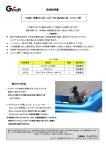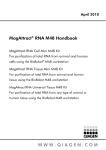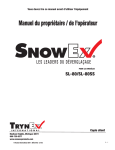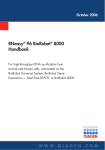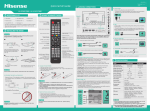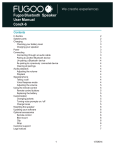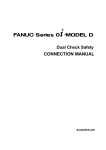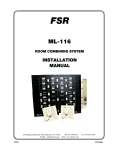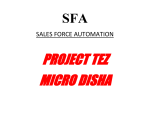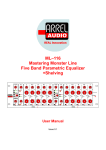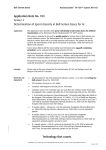Download MolBio Tech Data_new.cdr
Transcript
Product Unzipping Genes MB522 Information HiPurATM Sperm Genomic DNA Purification Kit Kit Contents 20 Preps 5 ml MB522 50 Preps 10 ml 250 Preps 50 ml Semen Wash Buffer Concentrate (SEW) 12 ml 28 ml 135 ml DS0039 Sperm Lysis Buffer (SL) 4 ml 8 ml 30 ml DS0010 Lysis Solution (C1) 6 ml 14 ml 65 ml DS0012 Wash Solution Concentrate (WS) 10 ml 30 ml 100 ml DS0040 Elution Buffer (ET) [10 mM Tris-Cl, pH 8.5] 6 ml 13 ml 60 ml MB086 Proteinase K 10 mg 24 mg 120 mg DS0003 RNase A Solution (20 mg/ml) 0.5 ml 1.1 ml 5.5 ml MB070 30.85 mg 77.12 mg 385.62 mg 22 nos 55 nos 260 nos DBCA016 DL-Dithiothreitol (DTT) HiElute Miniprep Spin Column ( Capped) [in DBCA016 Collection Tube] Collection Tube (Uncapped), Polypropylene (2.0 ml) 20 nos 50 nos 250 nos PW1139 Collection Tube, Polypropylene (2.0 ml) 40 nos 100 nos 2X 250 nos Product Code ML116 Resuspension Solution (1X PBS) DS0038 DBCA03 Reagents provided Introduction HiPurA Sperm Genomic DNA Purification Kit provides a fast and easy method for purification of total DNA for reliable applications in PCR and Southern blotting technique. The DNA purification procedure using the miniprep spin column comprises of three steps viz. adsorption of DNA to the membrane, removal of residual contaminants and elution of pure genomic DNA. HiMedia’s HiElute Miniprep Spin Column (Capped) format allows rapid processing of multiple samples. The columns have a high binding capacity and high quality genomic DNA is obtained from various species. The DNA obtained is compatible with downstream applications such as restriction endonuclease digestion, PCR and Southern blotting. HiPurATM Sperm Genomic DNA Purification Kit This kit simplifies isolation of DNA from sperm samples with spin column procedure. Following lysis, DNA binds to the silica gel membrane of the HiElute Miniprep Spin Column (Capped) to yield high purity DNA. Two rapid wash steps remove trace salts and protein contaminants resulting in the elution of high quality DNA in the Elution Buffer (ET) provided with the kit. HiElute Miniprep Spin Column (Capped) [DBCA03] HiElute Miniprep Spin Column (Capped) is based on the advanced silica binding principle presented in a microspin format. The system efficiently couples the reversible nucleic acid-binding properties of the advanced silica gel membrane and the speed plus versatility of spin column technology to yield high quantity of DNA. The use of spin column facilitates the binding, washing and elution steps thus enabling multiple samples to be processed simultaneously. This column eliminates the need for alcohol precipitation, expensive resins, and harmful organic compounds such as phenol and chloroform, otherwise employed in traditional DNA isolation techniques. DNA binds specifically to the advanced silica-gel membrane while contaminants pass through. PCR inhibitors such as divalent 1 WHO GMP CERTIFIED Registered Office : Commercial Office 23, Vadhani Industrial Estate,LBS Marg, Mumbai - 400 086, India. Tel. : (022) 4017 9797 / 2500 1607 Fax : (022) 2500 2286 A-516, Swastik Disha Business Park, Via Vadhani Indl. Est., LBS Marg, Mumbai - 400 086, India Tel: 00-91-22-6147 1919 Fax: 6147 1920, 2500 5764 Email : [email protected] Web : www.himedialabs.com The information contained herein is believed to be accurate and complete. However no warranty or guarantee whatsoever is made or is to be implied with respect to such information or with respect to any product, method or apparatus referred to herein cations and proteins are completely removed in two efficient wash steps, leaving pure nucleic acid to be eluted in the buffer provided with the kit. Elution Elution with 200 µl of Elution Buffer (ET) or Molecular Biology Grade Water will provide sufficient DNA to carry out multiple amplification reaction. Elution with volume less than 200 µl will increase the final DNA concentration, but will reduce the overall DNA yield. Concentration, yield and purity of DNA Spectrophotometric analysis and agarose gel electrophoresis will reveal the concentration and the purity of genomic DNA. Use Elution Buffer to dilute samples and to calibrate the spectrophotometer, measure the absorbance at 260 nm, 280 nm, and 320 nm using a quartz microcuvette. Absorbance readings at 260 nm should fall between 0.1 and 1.0. The 320 nm absorbance is used to correct for background absorbance. An absorbance of 1.0 at 260 nm corresponds to approximately 50 µg/ml of DNA. The A260–A320 /A280–A320 ratio should be 1.6 –1.9. Purity is determined by calculating the ratio of absorbance at 260 nm to absorbance at 280 nm. DNA purified by HiPurA Sperm Genomic DNA Purification Kit is free of protein and other contaminants that can inhibit PCR or other enzymatic reactions. Concentration of DNA sample (µg/ml) = 50 x A260 x dilution factor. Materials needed but not provided • • • • • • • • Incubator at 55°C 70°C water bath or heating block Tabletop Microcentrifuge (with rotor for 2.0 ml tubes) Ethanol (96 – 100%) Corex® (or any other suitable material) centrifuge tubes Lymphocyte Separation Medium (LSM) (Product Code: LS001) (Optional) Clean and dry bottle of appropriate capacity (for dilution of SEW Buffer) (Refer point 5 of General Preparation Instructions) Molecular Biology Grade Water (Product code: ML024) Storage Store the HiPurA Sperm Genomic DNA Purification Kit between 15-25°C except certain components as specified on each labels. Under recommended condition kit is stable for 1 year. General Preparation Instructions 1. Set the incubator at 55oC (For incubation of semen sample / semen pellet with Buffer SL to form semen lysate) 2. Preheat a water bath or heating block to 70°C. 3. Thoroughly mix reagents Examine the reagents for precipitation. If any kit reagent forms a precipitate (other than enzymes), warm at 55-65°C until the precipitate dissolves and allow cooling to room temperature (15-25°C) before use. 4. Preparation of Sperm Lysis Buffer (SL) (DS0039) To 100 µl of Sperm Lysis Buffer (SL), add 20 µl of the Proteinase K solution (20 mg/ml) (MB086) (Refer to step 8 of General Preparation Instructions) and 8 µl of 1M DTT (MB070), just before use. Mix thoroughly by vortexing for 10-15 seconds. NOTE: Sperm Lysis Buffer (SL) can be used effectively for semen as well as sperm sample. 2 5. Dilute Semen Wash Buffer Concentrate (SEW) (DS0038) as follows: Number of Preps Semen Wash Buffer Concentrate (SEW) Molecular Biology Grade Water 20 12 ml 228 ml 50 28 ml 532 ml 250 135 ml 2565 ml NOTE: User should carry out dilution of Semen Wash Buffer Concentrate (SEW) in a separate container, as it is not provided with this kit. 6. Dilute Wash Solution Concentrate (WS) (DS0012) as follows: Number of Preps 20 50 250 Wash Solution Concentrate (WS) 10 ml 30 ml 100 ml Ethanol (96-100 %) 30 ml 90 ml 300 ml 7. Reconstitute DTT (DL-Dithiothreitol) (MB070) Resuspend the DTT (DL-Dithiothreitol) powder in Molecular Biology Grade Water (Product code: ML024) to obtain a 1M stock solution. Number of Preps 20 50 250 DTT (DL-Dithiothreitol) 30.85 mg 77.12 mg 385.62 mg Molecular Biology Grade Water 0.2 ml 0.5 ml 2.5 ml The product as supplied is stable at room temperature (15-25°C), upon reconstitution store at -20°C in dark (wrapped in an aluminium foil), as mentioned in storage instructions. NOTE: The 1M DTT solution must be added directly to each sample preparation every time. 8. Reconstitute Proteinase K (MB086) The HiPurA Sperm Genomic DNA Purification Kit contains Proteinase K. Intensive research has shown that it is the optimal enzyme for use with the Lysis Solution provided in the kit. It is completely free of DNase and RNase activity. Proteinase K is the enzyme of choice for use with an SDS containing Lysis Solution. The specific activity of the Proteinase K is 33.5 units/mg dry weight. Resuspend the Proteinase K (MB086) powder in Molecular Biology Grade Water (ML024) to obtain a 20 mg/ml stock solution. Number of Preps Proteinase K Molecular Biology Grade Water 20 10 mg 0.5 ml 50 24 mg 1.20 ml 250 120 mg 6 ml The product as supplied is stable at room temperature (15-25°C), upon reconstitution store at -20°C as mentioned in storage instructions. NOTE: The Proteinase K solution must be added directly to each sample preparation every time. Do not combine the Proteinase K and Lysis Solution for storage. 9. Ensure that clean & dry tubes and tips are used for the procedure. 3 RNase A enzyme treatment RNase A is a type of RNase that is commonly used in research. RNase A (e.g., bovine pancreatic ribonuclease A) is one of the sturdiest enzymes in common laboratory usage. It cleaves 3'end of unpaired C and U residues. Unit Definition for RNase A One unit of the enzyme causes an increase in absorbance of 1.0 at 260 nm when yeast RNA is hydrolyzed at 37°C and pH 5.0. Fifty units are approximately equivalent to 1 Kunitz unit. It is completely free of DNases and proteases. The specific activity is more than 90 U/mg. The product as supplied is stable at room temperature (15-25°C). Centrifugation All centrifugation steps are carried out in conventional laboratory centrifuge e.g. Beckman CS-6KR, Heraeus Varifuge 3.0R, or Sigma 6k10 with fixed angle rotor. The tubes provided with the kit are compatible with almost all laboratory centrifuges and rotors. All centrifugation steps are performed at room temperature and are given in g, the correct rpm can be calculated using the formula: RPM = √RCF/1.118 x 10-5 r where RCF = required gravitational acceleration (relative centrifugal force in units of g); r = radius of the rotor in cm; and RPM = the number of revolutions per minute required to achieve the necessary g-force. Procedure 1. Washing of Semen Sample Add 10 ml of diluted Semen Wash Buffer (SEW) (DS0038) (Refer Step 5 of General Preparation Instructions) to 100-200 µl of semen sample in a Corex® (or any other suitable material) centrifuge tube and vortex at full speed for 10 seconds to ensure proper mixing. NOTE: Corex® tubes are recommended as sperm cells do not adhere strongly to the material of these tubes. NOTE: If only Sperm DNA is required, the other cells present in the semen sample, including lymphocytes, should be separated out using appropriate gradient technique, such as Lymphocyte Separation Medium (LSM) (Product Code LS001), to obtain only sperms in the sample which will be treated further for extraction of DNA. 2. Centrifuge at ≥ 2,500 x g (≈ 4,000 rpm) for 10 minutes. 3. Discard the supernatant, leaving behind approximately 1 ml of pellet and Semen Wash Buffer (SEW). Vortex for 10–15 seconds to ensure proper mixing of pellet and diluted Semen Wash Buffer (SEW), and transfer the contents into a 2.0 ml capped collection tube. 4. To the above sample, add 0.5 ml of diluted Semen Wash Buffer (SEW) and vortex for 10–15 seconds to collect any sample adhering to the walls of the tube. 5. Centrifuge at ≥6,500 x g (≈10,000 rpm) for 2 minutes. Carefully remove the supernatant, avoiding removal of the semen pellet. 6. Resuspension of pellet Resuspend the pellet in Resuspension Solution (1X PBS) (ML116) to make the final volume 100 µl. 4 7. Treatment with Sperm Lysis Buffer (SL) (DS0039) (Prepare Sperm Lysis Buffer as indicated in General Preparation Instructions) Add 100 µl of prepared Sperm Lysis Buffer (SL) (DS0039) to 100 µl of resuspended semen pellet from Step 6. Mix thoroughly by vortexing for 10-15 seconds. Incubate at 55°C for 1½ - 2 hours to ensure thorough lysis of the sample. Invert the tube intermittently for atleast 8-10 times for homogenous lysis of the sample during the incubation period. If residual RNA is not a concern, continue with step 8 to treat the semen lysate further. NOTE: More of intermittent shaking of the treated sample and less of pulse vortexing is recommended to prevent shearing of the sperm DNA. NOTE: If reduced incubation time is desired, the user will have to optimize the incubation time at 55°C accordingly, to ensure complete homogenization of the sample. Optional RNase A treatment If RNA-free genomic DNA is required, add 20 µl of RNase A Solution (DS0003) and incubate for 2 minutes at room temperature (15-25°C), then continue with step 8. 8. Lysis Add 200µl of Lysis Solution (C1) (DS0010) to 200µl of semen lysate from step 7. Mix by vortexing thoroughly for 10-15 seconds. A homogenous mixture is essential for efficient cell lysis. Incubate at 70°C for 10 minutes. NOTE: If any clumps are visible, the sample can be pipetted gently to obtain a homogenous mixture. 9. Prepare for Binding Add 200 µl of ethanol (96-100 %) to the lysate and mix thoroughly by vortexing for 5-10 seconds. NOTE: A homogenous solution is essential. 10. Load lysate in HiElute Miniprep Spin Column (Capped) [DBCA03] Transfer the lysate obtained from step 9 onto the column provided. Centrifuge at ≥6,500 x g (≈10,000 rpm) for 1 minute. Discard the flow-through liquid and place the column in a same 2.0 ml uncapped collection tube. NOTE: Use a wide bore pipette tip to reduce shearing of the DNA while transferring contents into the column. 11. First Wash (Prepare Wash Solution as indicated in General Preparation Instructions) Add 700 µl of diluted Wash Solution (WS) to the column. Centrifuge at ≥6,500 x g (≈10,000 rpm) for 1 minute. Discard the flow-through liquid and re-use the same collection tube with the column. 12. Second Wash Add another 700 µl of diluted Wash Solution (WS) to the column and centrifuge at 12,00016,000 x g (≈13,000-16,000 rpm) for 3 minutes to dry the column. Discard the flow-through liquid and centrifuge the column for another minute at the same speed if residual ethanol is observed NOTE: (i) The column must be free of ethanol before eluting the DNA. (ii) The collection tube can be emptied and re-used for this additional centrifugation step. 5 13. DNA Elution Place the column in a new 2.0 ml uncapped collection tube. Pipette 100 µl of the Elution Buffer (ET) (DS0040) directly onto the column without spilling to the sides. Incubate for 1 minute at room temperature (15-250C). Centrifuge at ≥6,500 x g (≈10,000 rpm) for 1 minute to elute the DNA. Repeat the step again with another 100 µl of Elution Buffer (ET) for high yield of DNA. NOTE: DNA elution can also be performed in single step by the addition of 200 µl of Elution Buffer (ET) at a time (DNA yield would be low). Storing DNA in water may cause acid hydrolysis. To increase the elution efficiency, incubate for 5 minutes at room temperature (15-25°C) after adding the Elution Buffer (ET), then centrifuge. Elution with volume less than 200 µl increases the final DNA concentration in the eluate significantly, but slightly reduces the overall DNA yield. Storing DNA in water may cause acid hydrolysis. 14. Transfer the eluate to a fresh capped 2ml collection tube for longer DNA storage. Storage of the eluate with purified DNA: The eluate contains pure genomic DNA. For short- term storage (24-48 hrs) of the DNA, 2-8°C is recommended. For long-term storage, -20°C or lower temperature (-80°C) is recommended. Avoid repeated freezing and thawing of the sample which may cause denaturing of DNA. The Elution Buffer will help stabilize the DNA at these temperatures. Alternative Short Protocol 1. Treatment with Sperm Lysis Buffer (SL) (Prepare Sperm Lysis Buffer as indicated in General Preparation Instructions) Add 100 µl of prepared Sperm Lysis Buffer (SL) (DS0039) to 100 µl of semen sample. Mix thoroughly by vortexing for 10-15 seconds. Incubate at 55°C for 1½ - 2 hours to ensure thorough lysis of the sample. Invert the tube intermittently for atleast 8-10 times for homogenous lysis of the sample during the incubation period. If residual RNA is not a concern, continue with step 2 to treat the semen lysate further. NOTE: More of intermittent shaking of the treated sample and less of pulse vortexing is recommended to prevent shearing of the sperm DNA. NOTE: If reduced incubation time is desired, the user will have to optimize the incubation time at 55°C accordingly, to ensure complete homogenization of the sample. Optional RNase A treatment NOTE: RNase A treatment is generally not required while working with direct semen sample lysis method. The RNase in the seminal plasma is generally sufficient to ensure degradation of the sperm RNA. However, if RNase treatment is still needed, add 20 µl of RNase A Solution (DS0003) to semen lysate from Step 1 and incubate for 2 minutes at room temperature (15-25°C). Continue with step 2. 2. Lysis Add 200µl of Lysis Solution (C1) (DS0010) to 200µl of semen lysate from step 1. Mix by vortexing thoroughly for 15 seconds. A homogenous mixture is essential for efficient cell lysis. Incubate at 70°C for 10 minutes NOTE: If any clumps are visible, the sample can be pipetted gently to obtain a homogenous mixture. 3. Continue with steps 9-13 of the regular procedure to extract sperm DNA from the sample. 6 Quality Control Each lot of HiMedia’s HiPurA Sperm Genomic DNA Purification Kit is tested against predetermined specifications to ensure consistent product quality. References 1. Sambrook, J., et al. Molecular Cloning: A laboratory Manual, 2nd ed. (Cold Spring Harbor Laboratory Press, Plainview, NY, 1989) 2. Birren, B. and Lai, E. Pulsed Field Gel Electrophoresis: A practical guide (Academic Press, San Diego, CA, 1993) Troubleshooting guide Sr.No Problem 1. Spin column is clogged Possible Cause Lysate/ethanol mixture is not homogenous DNA elution is improper Ethanol was omitted during binding Eluate contains residual ethanol from the wash Use of water instead of Elution Buffer for elution of DNA 2. 3. Purity of the DNA is lower than expected; (A260/A280 ratio is low) Eluate was diluted in water for absorbance measurement. Background reading is high due to silica fines Purity of the DNA is higher than expected; (A260/A280 ratio is RNA contamination Please refer disclaimer Overleaf. 7 Solution Vortex the tubes for atleast 5-10 seconds in order to obtain a homogenous solution before applying it to the column. If minimally sheared DNA is required for downstream applications like PCR, mix with gentle pipetting or inversion until homogenous lysate is obtained, instead of vortexing. Ensure that the DNA elution is in 200µl of Elution Buffer. To improve the DNA yield incubate for 5 minutes at room temperature after Elution Buffer is added to the column. Ensure that ethanol is added in step 9 before adding the sample to the spin column in step 10. Remove ethanol from the second wash completely before eluting the DNA. Spin for an additional 2 minute to dry the membrane completely. In order to avoid the interference of ethanol, always use a fresh tube for elution. Elution Buffer is recommended for optimal yields and storage of the genomic DNA. If water is used instead of the Elution Buffer the pH should be at least 7.0, to avoid acidic conditions which may cause acid hydrolysis of DNA when stored for long periods of time. NOTE: Only DNase/RNase and Protease free water should be used for eluting DNA. Use either the Elution Buffer provided, or 10 mM Tris-HCl, pH 8.5. Spin the DNA sample at maximum speed for 1 minute, the supernatant can be used to repeat the absorbance readings RNase A treatment can be included in future isolations or the final product can be treated with RNase A Solution and repurified. too high) 4. Shearing of genomic DNA Improper handling of genomic DNA 5. Downstream applications are inhibited Traces of ethanol present in the final genomic DNA preparation Salt is carried over in the final genomic DNA preparation All pipetting steps should be carried as gently as possible. Wide bore pipette tips are recommended to eliminate shearing of the DNA to a large extent. If the isolated DNA is to be used for PCR, mix with gentle pipetting or invert until homogenous solution is obtained to reduce shearing of DNA considerably. After the washing steps the eluate should not come in contact with the column. Spin the column for 1 minute at maximum speed (12,000-16,000 x g) if necessary, after emptying the collection tube. The spin column should be transferred to a new 2.0 ml collection tube before adding the elution buffer. Safety Information The HiPurA Sperm Genomic DNA Purification Kit is for laboratory use only, not for drug, household or other uses. The Lysis Solution (C1) contains chaotropic salts, which are irritant. Take appropriate laboratory safety measures and wear gloves when handling. Not compatible with disinfecting agents containing bleach. Technical Assistance At HiMedia, we pride ourselves on the quality and availability of our technical support. For any kind of technical assistance, send an email to [email protected]. PIMB522_0/0514 MB522-06 Disclaimer : User must ensure of the product(s) in their application prior to use. Products conform solely to the information contained in this and other related HiMedia™ Publications. The information contained in this publication is based on our research and development work and is to the best of our knowledge true and accurate. Himedia™ Laboratories Pvt Ltd reserves the right to make changes to specifications and information related to the products at any time. Products are not intended for human or animal diagnostic or therapeutic use but for laboratory, research orfurther manufacturing use only, unless otherwise specified. Statements contained herein should not be considered as a warranty of any kind,expressed or implied, and no liability is accepted for infringement of any patents. A-516, Swastik Disha Business Park, Via Vadhani Indl. Est., LBS Marg, Mumbai - 400 086, India Customer Care No.: 022-6147 1919 Email: [email protected] 8








